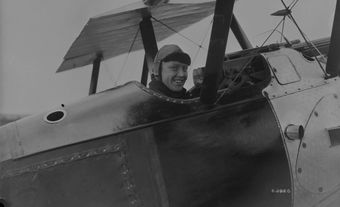Robert Ross
Robert Ross, British army officer, military figure in the WAR OF 1812 (b at Rostrevor, County Down, Ireland, 1766; d near Baltimore, Maryland, 11 Sept 1814). Robert Ross completed his education at Trinity College, Dublin, before being commissioned as an ensign in the 25th Foot on 1 August 1789. By December 1795, he had obtained a majority in the 90th Regiment but the battalion was disbanded.In 1799, Ross transferred to the 20th Foot, and he witnessed his first combat during the Duke of York's expedition to the Netherlands. In 1800, Ross joined Lieutenant-General Sir Ralph Abercromby's expedition to Egypt, where he distinguished himself during the capture of Alexandria. He served with distinction during the NAPOLEONIC WARS.
War of 1812
Once the war in Europe ended, Ross received command of a 3400-man brigade that joined a fleet under Vice Admiral Sir Alexander COCHRANE and his subordinate Rear Admiral George COCKBURN at Bermuda. They were to conduct raids in Chesapeake Bay as a diversion for operations being mounted against the US from the Canadas. The British also sought retaliation for the destruction of several communities in UPPER CANADA. Ross was uneasy about the goals of the expedition, which he felt had little military value, while the destruction of public property reduced soldiering to marauding and could strengthen American determination. Conversely, Cockburn enthusiastically supported the campaign's objectives, including the burning of Washington.
The combined force entered Chesapeake Bay and then sailed up the Patuxent until they reached Benedict, Maryland. Ross's men, augmented by marines, landed on 18 August. Ross marched off, uncertain whether to strike at Washington or Baltimore, ensuring his men became acclimatized by marching in careful stages. Heavy guards protected his flanks. At Marlborough, Ross halted for a day and then decided to march the 25 kilometres to Washington rather than the 50 kilometres to Baltimore.
Burning of Washington
At Bladensburg on 24 August, during the final approach to the American capital, Ross's brigade repelled 6000 American troops under Brigadier General William Winder. WASHINGTON was occupied by that evening. Ross took pains to ensure the protection of private property and restricted the movements of his troops in the city. During the course of the evening and the following day, however, all the public buildings, which were legitimate military targets, including the Capitol, the Supreme Court, offices, barracks, the arsenal, dockyard and the President's Mansion, were burned. The troops left Washington the next night and re-embarked on the 30th.
Ross's Death at North Point
The fleet then sailed toward Baltimore and landed Ross's brigade at NORTH POINT on 11 September. The city was 23 kilometres away through thickly wooded country. Ross intended to test the defences and attack the city if possible. The Americans were better prepared than at Washington and 6000 militiamen had been assembled. When the first shots were fired, Ross rode forward to view the action and was mortally wounded. The advance resumed under the command of Colonel Francis Brooke. A joint attack against the defences proved unfeasible as the Americans had sunk 24 vessels across the harbour, making an approach impossible. Naval bombardment of Forts McHenry and Covington throughout 13 September brought little damage. Brooke and Cockburn then decided to withdraw. The bombardment provided Francis Scott Key with the inspiration to write a patriotic verse that in 1931 became the American national anthem.
The British troops were re-embarked by 15 September. They brought Ross's body with them and he was eventually buried in Halifax, Nova Scotia.

 Share on Facebook
Share on Facebook Share on X
Share on X Share by Email
Share by Email Share on Google Classroom
Share on Google Classroom


